



Top Profit Robbers in a Sow Farm
Factors identified by Mark Chambers (Sunterra Farms) and Catherine Templeton (South West Vets) as most adversely impacting the profitability of the breeding herd are incorrect sow feeding levels, poor semen management, excessive herd replacement rates and insufficient focus on weekly pig flow rates. They were addressing the 2013 London Swine Conference.
1. Sow Feed – Not Getting It Right
Introduction
Sow feed is a critical part of operating a sow farm and one of the biggest costs. Getting it right can be a challenge. Feeding the target feed to the herd may be achieved but getting it delivered to the right sows is the biggest issue seen across farms. Agreeing on what body condition is ideal can be done but delivering an ideal condition sow to the farrowing rooms can be difficult. Creating charts to follow is an option but getting the staff to follow them is tough!
Gestation sow feed targets
Getting the target set for feeding sows is pretty easy. Work with a nutritionist who will set the volumes or weights based on the energy of the ration, sow condition and weight. This can then be translated into a simple table (e.g. Figure 1). Weighing and/or probing each sow helps to fit her into the feed table. Then feed accordingly.

Delivering the feed to gestation sows
While weighing each sow is probably not practical, it is possible to tape the sow to estimate the weight or simply slot her into a parity category. The goal is to place the animal in a weight category then condition score her to slot her into a back fat category. Use this to set the feeder at the desired amount.
This may seem quite simple but the challenging part is getting everyone to agree on body condition. This takes time, pictures and reiteration with everyone involved in doing it. One method is to take photos of sows at different body conditions. Put this on a laminated sheet for staff to carry. This helps keep everyone on track to keep things consistent.
Farrowing feed
This is the time to feed the sow as much as she can eat. The goal is to maximize feed intake to get good milk production and litter growth. There are two systems for feeding lactating sows:
- meal feeding according to need 2-3 times per day or
- ad lib.
Ad lib
Ad lib can be easier as the sow will regulate her own intake. More farms are moving to ad lib as it takes some of the guess work out of feeding. It saves on wasted feed from cleaning out feeders, and in general, lactation sow feed intake will be higher on this system. The main challenge is to identify sows not eating a set minimum amount per day. There should be a system in place to check at least once per day, who has and has not, eaten and how much. If sows are eating at least the minimum amount they should be okay.
Meal feeding
With this system, sows are fed two or three times per day according to the amount that they have eaten at the previous meal. This system is inherently limiting on intake. The challenge is to maximize feed intake without wastage. Feed cards with intake targets should be used with this system to be able to monitor intake and feed accordingly. Figure 2 shows an example of targets.
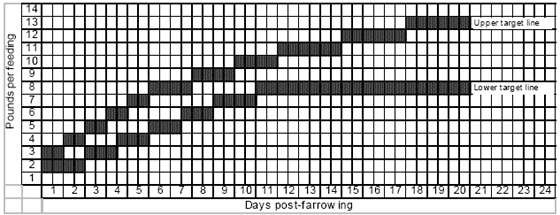
Conclusions
The big question is “can sow feed be a profit robber?” The answer is yes! It can be a hidden one as you don’t see it every day. These are things to think about:
- Sow feed usage needs to be monitored on the farm on a weekly or monthly basis. A nutritionist can help to set reasonable targets based on ration density. This is essential to avoid over- or under-feeding.
- Sow condition needs to be look at monthly by a “different” set of eyes. The correct amount of feed may be used by the farm but is it getting to the right sows? Variation can be an issue!
- Cleaning feeders out down the pit in farrowing can be very costly.
- If the herd is overfed, there will be sows that are too fat, resulting in farrowing difficulties, poor lactation intake, lower piglet weaning weights, and subsequent reproduction problems.
- If the correct amount of feed is used but it is going to the wrong animals there will be variation in condition within the herd (thin and fat sows) and this will have a negative impact on reproduction.
2. Semen Management
Introduction
To ensure that sows are bred to the best of the system ability it is critical to ensure that fresh semen is available for use each day however it is just as important not to overdo how much semen is available as it ends up being used as old semen or thrown away. This can become very expensive. It is a balance between having semen available and not running out!
Monitor usage
In order to manage it you need to be able to measure it! Each month, tally up the total number of matings. This would include single matings, multiple matings, and extra doses used due to leak back. Account for every dose used then look at the number of doses that were purchased. This comparison sometimes shows surprising wastage!
Put an opportunity cost beside it to show the cost of semen wastage. Figure 3 is an example of what can be used to monitor usage/wastage. There will be some carryover each month due to when the semen was delivered and what is in the fridge but tracking month over month and having a YTD opportunity cost shows the whole picture.
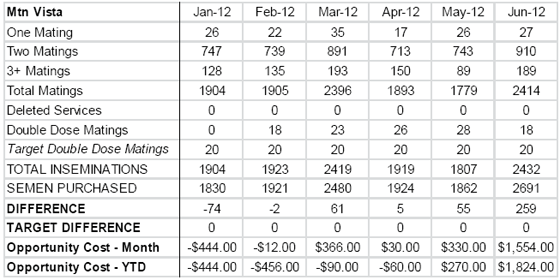
This is a real farm example and back in 2002 the cost of throwing out semen was $35,000!! This was what spearheaded the need to look at wastage. Measure the wastage and multiply by the cost per dose. This will give you your opportunity cost!
Conclusions
Can semen be a profit robber? Yes! If not managed correctly it can easily run away on you. Make sure you have a system in place to account for the use. Make sure staff are aware of the goal when ordering semen. Today with the long lasting extenders it is not such a big deal using older semen.
If you don’t measure it, you can’t manage it!
3. Gilt Attrition
Introduction
Every producer knows how crucial a regular supply of quality gilts is to their sow operation and most producers understand what their herd replacement rate is, but many do not track what their young sow attrition rate is. Why is this critical? Young sows have an up-front cost that includes:
- The actual cost of the gilt over the value of the cull sow
- The holding time from entry to breeding.
- The lower productivity of younger parity animal (litter size and sometimes litters/sow/year).
- The effect that young sows have on reducing herd immunity.
We need our young sows to stay in the herd and become old sows in order to maximize herd productivity!
Tables 1 and 2 are examples of two herds with very different gilt retention rate. In Herd A, 87.57 % of the gilts that enter have 3 litters. In Herd B, that number is only 71.99%. This is the major production parameter difference between these two herds and it drives a difference in 2 pigs per sow per year. This report is a standard report in the PigKNOWS sow data system and similar reports are available in other systems as well. Remember, to use this information, new gilts need to be added to the sow information database, when they are eligible to be bred.
To track this manually, record how many young animals are culled compared to the number of new gilts added. The target is for 93-95% of gilts entering a herd to have a first litter and 80% of these to have a third litter.
How do you get there?
- Have access to a good supply of health compatible gilts. If you are having trouble introducing gilts, talk to your veterinarian to get help planning a smooth introduction program.
- Breed sexually mature gilts at a designated minimum size. All gilts should be on second heat or greater at breeding.
- Feed and maintain the gilts in such a manner that they are in good condition after weaning their first litter and are ready to be rebred.
Table 1. Herd A: Pigs weaned /sow/year = 25.2; replacement rate = 30.2%.
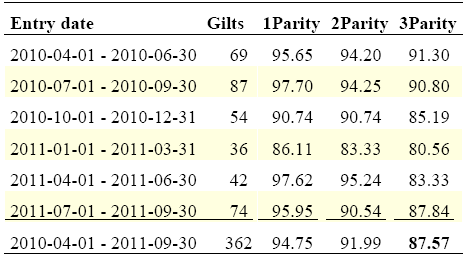
Table 2. Herd B: Pigs weaned per sow per year = 23.2; replacement rate = 41.2%
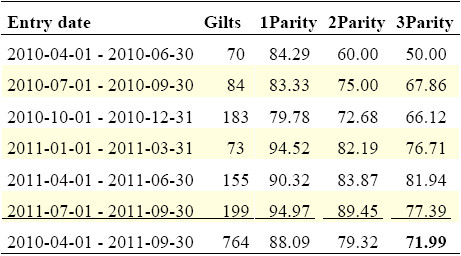
4. Targeting Pigs Weaned per Sow per Year Instead of Weekly Pig Flow
Introduction
The classical method for measuring sow herd productivity is pigs weaned per sow per year, but steady production of a consistent targeted number of pigs per week (or per group on a batch system) has tremendous value. This has two components.
Consistent weekly farrowing and pig numbers allows for the most efficient use of facilities and produces the most consistent product. Inconsistent weekly farrowing numbers translates into problems with:
- Variation in age and size at weaning
- Subsequent litter reproductive losses from sows weaned early
- Increased cost of raising those pigs
- Lost opportunities for use of fostering and nurse sows
- Lost opportunities for culling on productivity as substandard animals are kept to maintain breeding numbers.
A Farrowing Rate report is essential for tracking this information (Figure 4).
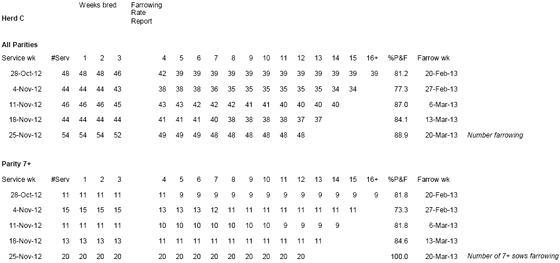
To achieve this consistency, the producer needs to use a push system to ensure that old animals are culled and replaced:
- Have a consistent supply of ready-to-breed replacement gilts.
- Have recorded heats on all gilts.
- Have an understanding of what replacements are needed on a weekly basis.
- Manipulate heats if necessary to achieve targeted replacements regular weekly breed.
Pigs per week (or batch) pay the bills. Modest sow herd inventory adjustment to maintain pig output while production issues are being sorted out more than pays for itself.
Example
A 1,000-sow herd has a desire to achieve 26 pigs per sow and year. Targeted pig flow is 500 weaned pigs per week.
They are currently breeding 55 sows per week and farrowing 50 sows (90 per cent farrowing rate) with 10 pigs weaned per sow. In September, the herd manager notices that his repeat rate is increasing and his projected farrowing rate is only 83 per cent. To maintain pig flow, he needs to increase his breedings per week by five (assume 50 extra sows in the herd). The annual carrying cost of those 50 sows, in just feed and semen, is $19,370 per year or $372 per week (assume feed at $325 per tonne). However, if the manager chooses to ignore the warning signs (repeats) and maintains his breeding target at 55, the weekly output of pigs drops to 456. This translates to a $1,540 a week drop in revenue.
The solution: Adjust the targets immediately to maintain pig flow and cash flow. Work at fixing the production problem to improve efficiency.
Income scenario 1: 500 × $35 per weaned pig = $17,500 per week.
Income scenario 2: 456 × $35 per weaned pig = $15,960 per week (-$1540 per week).
Income scenario 3: 500 × $35 per weaned pig = $17,500 per week - $372 feed and semen cost for extra animals = $17,128 net.
Failure to maintain consistent pig out-flow is a top profit robber in the sow herd.
Conclusions
Stopping the top profit-robbers in sow herds depends on controlling costs and maintaining targeted herd output. To control costs, focus on the major items:
- feed and feed management
- genetics – manage semen use and gilt replacements to minimize cost to the herd.
To maintain income, focus on maintaining targeted pig outflow through:
- striving for consistency in weekly (or batch ) production
- maximising gilt retention, via good gilt management, and
- understand the age structure of each farrowing group and plan for replacement of older sows (a push system).
July 2013






